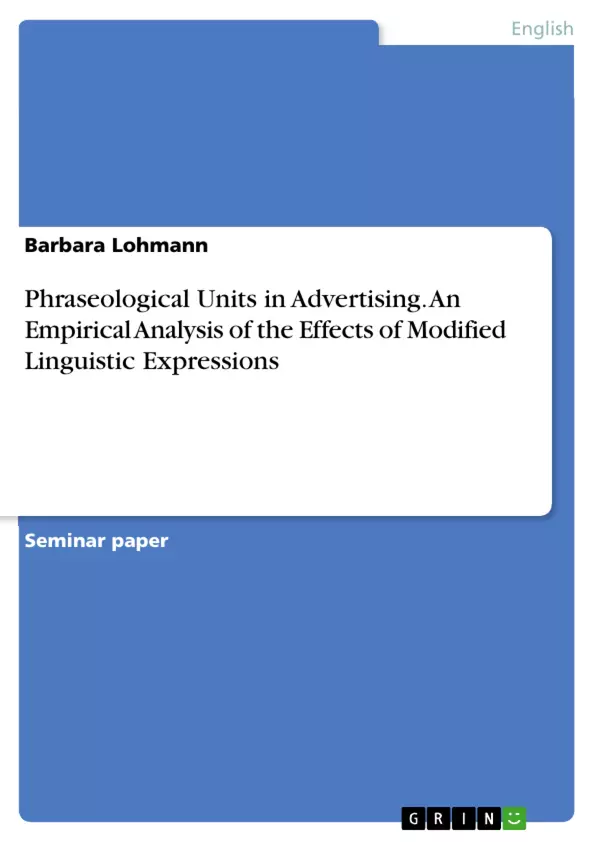Since Leech published his pioneering work English in Advertising in 1966, the relevance of advertising increased steadily in linguistics during the twentieth century (Bell, 1995: 32). The term advertising itself means ‘to turn towards’, thus one of the central and obvious aims of advertising is to get the recipient’s attention (Goddard, 1998: 6). Additionally, the initiator aims to attract and persuade a specific target group and thus consciously intends to benefit from the textual components of an advertisement, either directly and commercially or indirectly through an enhanced brand image (Goddard, 1998: 7). Hence advertising texts often involve a complex interpretation of the reader decoding the message (Goddard, 1998: 10). Developing a persuasive and successful advert demands a high degree of creativity and linguistic skills (Bell, 1995: 32). Besides metaphors, puns or alliterations, phraseological units are frequently used as a popular tool in advertising language (Bell, 1995: 32; Fiedler, 2007: 103).
In the following, my focus will be on the topic of modification of phraseological units in advertising as beneficial influencer on the audience’s attitude towards a product, using the example of a print advert of Volkswagen’s ‘As sun as possible’ campaign for the Beetle Cabriolet. The aim of this work is to prove the relevance and the favourable effects of transformed phraseological units in an empirical study dealing with the advert of Volkswagen. Phraseological Units are modified in the ‘As sun as possible’ campaign of Volkswagen to profit from the underlying original meaning and to add a personalised meaning fitting the particular product in order to favourably and efficiently affect the relevant audience.
In order to show this, the present work will first create a theoretical basis about the concept of phraseological units. There, I will concentrate on the terminology and explain central features of phraseological units and how they are used in adverts. Then I will initially consider the possibilities for a modification of phraseological units on a general basis. In the following, this knowledge will be expanded by an elaboration of the most frequently used techniques for modification in advertising and an explanation of the advantages and challenges. This theoretical knowledge about phraseological units and their features will be exemplarily applied to the ‘As sun as possible’ campaign of Volkswagen...
Inhaltsverzeichnis (Table of Contents)
- Introduction
- Characteristics of Phraseological Units
- Determination of Phraseological Units
- Definition
- Features of Phraseological Units
- Modification of Phraseological Units in Advertising
- Characteristics of Modification
- Common Types of Modification in Advertising
- Advantages and Challenges
- Application of Phraseological Units in the ‘ASAP' Campaign of VW
- Determination of Phraseological Units
- Empirical Analysis – Effects of Phraseological Units in Advertising
- Data Collection and Analysis
- Description and Interpretation of Findings
- Findings of Warm-Up and Socio-Demographic Data
- Perception and Effects of Modification
- Conclusion
Zielsetzung und Themenschwerpunkte (Objectives and Key Themes)
This work aims to investigate the relevance and effectiveness of modified phraseological units in advertising, using the example of Volkswagen's 'As sun as possible' campaign for the Beetle Cabriolet. The study aims to demonstrate that transformed phraseological units can positively influence audience perception and attitude towards a product.
- The characteristics and features of phraseological units in language
- The application of phraseological units in advertising, specifically focusing on modification techniques
- The advantages and challenges of modifying phraseological units in advertising
- An empirical analysis of the perception and effects of Volkswagen's 'As sun as possible' campaign on the target audience
- The role of phraseological units in shaping brand image and consumer behavior
Zusammenfassung der Kapitel (Chapter Summaries)
The first chapter introduces the concept of phraseological units, outlining their relevance in advertising and the importance of their modification for persuasive messaging. Chapter two delves into the theoretical framework of phraseological units, defining them, explaining their key features, and exploring the various techniques used for modification in advertising. It also discusses the advantages and challenges of employing modified phraseological units in creating impactful advertisements.
Chapter three presents an empirical analysis of the effects of Volkswagen's 'As sun as possible' campaign. It outlines the data collection and analysis methods used in the study and provides an interpretation of the findings, focusing on the perception and effects of the modified phraseological units on the target audience.
Schlüsselwörter (Keywords)
The primary focus of this work revolves around phraseological units, their modification in advertising, and the empirical study of their effects. Key terms include phraseological units, idioms, modification, advertising language, Volkswagen, 'As sun as possible' campaign, Beetle Cabriolet, consumer perception, and brand image.
- Quote paper
- Barbara Lohmann (Author), 2014, Phraseological Units in Advertising. An Empirical Analysis of the Effects of Modified Linguistic Expressions, Munich, GRIN Verlag, https://www.grin.com/document/277601



